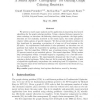Free Online Productivity Tools
i2Speak
i2Symbol
i2OCR
iTex2Img
iWeb2Print
iWeb2Shot
i2Type
iPdf2Split
iPdf2Merge
i2Bopomofo
i2Arabic
i2Style
i2Image
i2PDF
iLatex2Rtf
Sci2ools
COR
2010
2010
A search space "cartography" for guiding graph coloring heuristics
We present a search space analysis and its application in improving local search algorithms for the graph coloring problem. Using a classical distance measure between colorings, we introduce the following clustering hypothesis: the high quality solutions are not randomly scattered in the search space, but rather grouped in clusters within spheres of specific diameter. We first provide intuitive evidence for this hypothesis by presenting a projection of a large set of local minima in the 3D space. An experimental confirmation is also presented: we introduce two algorithms that exploit the hypothesis by guiding an underlying Tabu Search (TS) process. The first algorithm (TS-Div) uses a learning process to guide the basic TS process toward as-yet-unvisited spheres. The second algorithm (TS-Int) makes deep investigations within a bounded region by organizing it as a tree-like structure of connected spheres. We experimentally demonstrate that if such a region contains a global optimum, TS-...
| Added | 09 Dec 2010 |
| Updated | 09 Dec 2010 |
| Type | Journal |
| Year | 2010 |
| Where | COR |
| Authors | Daniel Cosmin Porumbel, Jin-Kao Hao, Pascale Kuntz |
Comments (0)

